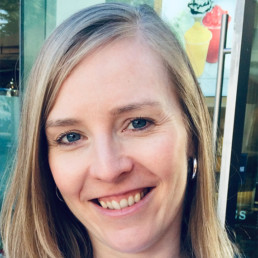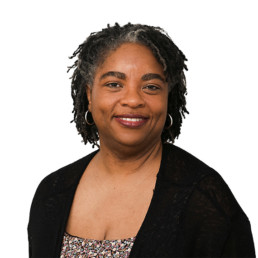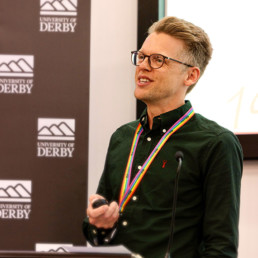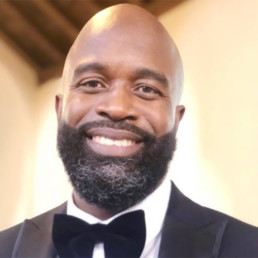What Is the Point of Dialogue?

Written by Sharon Booth
Founder & Director, Solutions Not Sides. Sharon has an MA from Cambridge University in Theology and Religious Studies. She taught English at Amideast in Tunisia and then went on to work in Amman, Jordan as a Productions Manager. She was employed as PA to the Defence Attaché at the British Embassy, then returned to the UK and began work in Israeli-Palestinian conflict resolution, founding the Solutions Not Sides Education Programme in 2010. Sharon speaks Arabic and French and has studied ancient Hebrew. In January 2016, she was awarded a master’s degree with distinction from King's College London, specialising in nationalism and religion.
Dialogue is fundamental to building relationships and resolving differences. It is a crucial tool for addressing conflicts, yet when pain and injustice run deep, the idea of engaging in dialogue can feel futile—or even wrong.
When faced with deep moral disagreements, people may question whether dialogue is worthwhile. Engaging with opposing viewpoints can feel uncomfortable and even counterproductive. In such moments, the instinct may be to advocate solely for what feels right. Yet, it is precisely during these times that dialogue becomes most valuable—not necessarily to achieve agreement but to foster greater empathy, reflection, and mutual understanding.
Dialogue in a Polarised World
These challenges are heightened in times of deep societal division. When issues are viewed in black-and-white terms, conflicts become entrenched, and meaningful conversations break down. This dynamic has been evident in Britain in recent years on topics like Brexit, immigration, and the Israel-Palestine conflict. Though often framed as binary, these issues are complex and multi-layered. Recognising this complexity is key to breaking through entrenched positions—but it can feel overwhelming, particularly for educators navigating these discussions in schools.
In England, the Department for Education requires teachers to maintain political impartiality in the classroom. While this guidance is intended to prevent partisan bias, it has also led to uncertainty about how to approach difficult topics. Some educators, lacking expertise in areas like the Middle East conflict, may choose to avoid these discussions altogether. However, shutting down conversations about political and social issues does a disservice to young people.
Without education on these topics and training in how to engage in difficult conversations, students miss out on opportunities to develop a nuanced understanding of the world. Worse, they may grow up ill-equipped to engage thoughtfully with societal challenges.
Dialogue as a Tool for Empowerment
This is where dialogue finds its true purpose—not as an end in itself but as a means to empower young people. At Solutions Not Sides (SNS), we developed the Olive Branch Award for schools, colleges, and community institutions as a framework for discussing Israel-Palestine. Rooted in values of non-violence, equality, and the rejection of hate, the programme takes a “win-win” approach to contentious issues. Within this structure, dialogue becomes a tool for critical thinking, helping students articulate their beliefs while respecting others’ perspectives.
The Olive Branch Award is not about reconciling opposing views or forcing agreement. Instead, its purpose is to foster understanding—of social dynamics, emotional experiences, and conceptual frameworks—so that students can make informed decisions about how to act. By engaging in dialogue within this framework, young people learn how to stand up for their beliefs while recognising that others may hold different views. Crucially, they also learn that hatred has no place in a diverse, compassionate, and fair society.
To be effective, dialogue must be approached with care and supported by specific tools that become embedded in school culture over time. Skills such as active listening, effective communication, and empathy are cultivated over a three-year period through the Olive Branch programme.
One common concern is that engaging with differing perspectives could be seen as endorsing them. However, dialogue is not about validating all views equally but about understanding why different perspectives exist. This allows students to reflect critically without feeling pressured to accept or condone harmful viewpoints.
At SNS, we emphasise that education is not about excusing or justifying views but about understanding why people hold them. This approach enables students to develop both intellectual rigour and emotional intelligence—essential qualities for active citizenship.
Supporting Schools Through the Olive Branch Award
Schools and colleges that participate in the Olive Branch Award benefit from a range of activities and resources designed to foster dialogue. We support staff and students through training, networking, an annual conference for staff, ambassador programmes, priority places on our residential courses for students, and opportunities to engage with peacebuilders from Israel-Palestine.
This summer, the first cohort of Olive Branch schools will complete the three-year programme and receive accreditation. Some of the initiatives we’ve seen include:
- Lunchtime and after-school clubs exploring conflict-related topics like journalism
- School murals dedicated to peace and justice
- Students founding interfaith initiatives in their schools
- Peer-to-peer learning projects following SNS workshops
These initiatives show that, when given the tools to navigate complex discussions, students become empowered to address difficult topics with inclusivity and empathy.
The Bigger Picture: Why Dialogue Matters
In today’s polarised world, it’s easy to feel disillusioned about dialogue, especially when faced with deep-seated divisions. But avoiding difficult conversations only fuels misunderstanding and hostility. Through structured dialogue, we can equip young people with the skills to engage with complexity with confidence and compassion.
The point of dialogue isn’t just to resolve differences; it’s to empower individuals to think critically, act ethically, and engage constructively—even with those they disagree with. In doing so, we prepare the next generation not just to lead but to build a society rooted in mutual respect and shared humanity.
At its core, dialogue is about more than talking—it’s about listening with purpose and acting with integrity. Within a framework that prioritises education over division and understanding over hate, it becomes one of the most powerful tools for creating a better future.
At The Reverse Mentoring Practice, we want to have BIG, game-changing conversations

Written by Stacy Johnson MBE
Chief Scientific Officer and Founder of The Reverse Mentoring Practice. Stacy is a leading voice on the frontier of justice, inclusion and belonging work. She helps organisations to re-imagine, re-engineer and reset their culture. Her groundbreaking work on reverse mentoring and practice supervision is making waves. Stacy is #TriniToDeBone
We want to talk about reverse mentoring in situations where you’re trying to improve inclusion, as an approach to retaining staff, and who may also be dealing with barriers to inclusion, who may find themselves in tricky situations and circumstances related to their protected characteristic. We do not want to have superficial conversations.
We want to celebrate the lived experiences of people through the magic of reverse mentoring, whether it is informal or formal, whether it’s programmatic in your organisation, or ad hoc.
We want to help you listen differently, to spark change in your organisations by empowering you and your senior leaders to move forward with cultural humility to ignite equitable action.
We sat down with Stacy Johnson MBE, our Chief Scientific Officer & Founder at Reverse Mentoring Practice who shared her insight and research on reverse mentoring. In the online seminar Stacy also held a question-and-answer session where one member asked:
Q: How can we get the people that would benefit from a mentoring relationship interested?
Stacy: Whether you are a very senior person or a junior person, you should periodically pause and assess.
Ask yourself: Am I being mentored? Am I mentoring anybody else? And if one of those things is not true, you need to make that right. You should always, at any point whether it’s formally or informally, be mentoring or being mentored.
It’s about reminding people on both sides of the equation that there is benefit from being a mentor and being mentored.
As far as those who are already converted, we should be more open about what mentoring is.
For example, the way I got a reverse mentor was because an amazing young man said to me, “will you mentor me?” And I actually felt a bit of horror. In fact, I remember saying to him, “I’m a terrible mentor! Let’s just meet and have some coffees!”
And then eventually, after several of those meetings, I said, “actually, will you reverse mentor me?”
I guess that’s because I had never been formally trained as a mentor. Some people have the impression that you have to be really knowledgeable, and you have to have all the answers. The idea of being formally asked to be a mentor is probably quite intimidating to even the most amazing leaders.
For me, I just want to have interesting conversations with this amazing young man and share ideas about things that had worked for me, things that I’d seen had worked for other people who were similar to him, or different to him. As soon as he labelled that mentoring, I panicked. So, it might be the same the other way around.
Maybe for the people who are not yet converted, it’s about offering it up as an informal relationship and connecting with somebody who is more junior to you, or more senior to you. Maybe that pulls them in, they begin to see the benefits and then they can happily then label it mentoring. They will be extolling the virtues of mentoring, and you won’t have to convince them.
If you want to know more, join us at the Diverse Educators webinar where we will explore how we unlock the potential of reverse mentoring and cultural humility in driving personal growth and organisational success. The recording will also be available to playback afterwards.
Committing to a queerer future in the university

Written by Alex Baird
they/them
Before moving to the Higher Educator sector seven years ago, I worked in various schools for over twelve years, latterly as Director of Sport. At the University of Bedfordshire I am a Senior Lecturer in Sport and Physical Education, an EDI Lead, and the Vice Chair of the LGBTQ+ Alliance staff network. I have just finished an EdD at UCL and the research I write about here constituted my EdD thesis.
In the process of moving from teaching in schools to lecturing in Higher Education (HE) and then embarking on a doctorate, I have been encouraged to read, reflect, and write more. I have gravitated towards my LGBTQ+ lived experiences and perspectives and I find myself increasingly motivated to carry out LGBTQ+ themed research. Being a LGBTQ+ researcher encompasses treading a different and uncertain path. In anticipating a few negative reactions to my research or worse still not being heard at all, I will attempt to speak calmly and clearly in order to bridge a connection and appeal to the shared interests that we might have between us.
LGBTQ+ leadership has often been excluded from UK HE, HE leadership research and wider leadership research, meaning leadership is narrowly understood (Lumby & Moorosi, 2022; Thomson, 2017). The individualistic, fixed, and binary conceptualisations of leadership, also enable and maintain prevailing power structures and inequalities (Ferry, 2017). For this reason, I was excited to hear about a proposed LGBTQ+ leadership development programme within the specific context and current climate of UK HE and further still when I was given access as a researcher to query leadership and leadership development.
The LGBT Leadership Development Programme I attended was delivered within one post-92 university and consisted of three formalised classroom days and individual mentorship. I had not anticipated, since I was not employed at the host university, being a participant as well as observer on programme days. However as soon as I arrived on day one, attendees drew me into the group and session activities. I tried to extend a reciprocal level of openness about my personal and professional experiences while balancing my role of observer, being interested without becoming too active. I learnt to wait a while and let other attendees ask a question before I did. I was invited to attend five further socials and three LGBTQ+ network events which brought me even closer to attendees’ lives. Attendees willingly engaged in interviews and I became aware of how their voices were entangled with other voices, the atmosphere of the programme’s queer space, their perceptions of the wider university, and their loyalty to the programme and its survival.
The energy, lightness, and freedom of the programme’s queer space produced new ways of thinking about, seeing, and enacting leadership. The community of LGBTQ+ attendees who came together (which included both academic and professional staff) facilitated intergenerational queer knowledge sharing amongst LGBTQ+ staff and offers an example of how distributed leadership and discussion works in practice. LGBTQ+ leadership was conceptualised as listening to, valuing, and developing people, and challenging inequalities by voicing an alternative perspective. A form of leadership which is relational, collective, creative, temporal, and offers some resistance to the negative pressures of neoliberalism. Enacting LGBTQ+ leadership was seen as being different (at times) from management rather than the two being interchangeable terms; attendees sheltered their team from or utilised market forces in UK HE to support inclusion and recognised that leadership did not necessarily require an authority role.
I know of three attendees who were promoted during or shortly after attending the programme however this overlooks the longitudinal, curvilinear, and wider outcomes for both attendees (mental wellbeing, career satisfaction, and career direction) and the organisation (development and retention of diverse talent). Instead of assimilating or conforming to normative versions of leadership, LGBTQ+ lives were attached to leadership with growing pride and joy. Crucially, though, the attendees in this queer space reflected upon and redefined the meaning given to authenticity (Fine, 2017), which was viewed by some attendees as beyond an ‘outness’ (recognising the nuances involved in this act), rather knowing oneself (an ongoing process) and embracing this. Whilst Authentic Leadership Theory (Avolio et al., 2004) fails to consider the complexities of relational and contextual factors, the attachment of this concept to the LGBTQ+ leadership development programme offered personal benefits to LGBTQ+ attendees’ wellbeing and leadership potential (Fletcher et al., 2024) and encouraged qualities in their leadership, which have been identified as being essential to UK HE (Spendlove, 2007; Bryman & Lilley, 2009).
The programme and LGBTQ+ mentorship readdressed feelings of powerlessness in the wider university, and nurtured and developed LGBTQ+ staff talent (and the university’s emerging leadership). This included mentors offering support when mentees applied for specific jobs during the programme’s duration and mentors explaining pathways for academic staff (which for some had been previously obstructed); clarifying the university’s systems and structures; and advising mentees to network with colleagues within HE. Attendees gained confidence to walk their own paths and voice alternative viewpoints. Attendees also spoke about the ‘softer’ merits of the programme, for example friendships continuing to blossom. Attendees viewed leadership development as a continual process of learning from and reflecting upon their leadership and life experience. It was also noted that progression was not always available, nor should it be the only aspiration, given the risk and limitation involved.
In sharing these findings to stimulate future versions of LGBTQ+ leadership development programmes I have been asked why a LGBTQ+ leadership development programme should be prioritised over other protected minority groups. I am not suggesting that LGBTQ+ staff have a superior need to others rather that this research indicates there is a value to leadership development programmes which have a specific focus and membership. However a LGBTQ+ leadership development programme would be particularly meaningful at this moment in time, when LGBTQ+ staff and students may be feeling less safe given the backdrop of a ‘culture war’ in the UK and a global ‘moral panic’ surrounding trans people. HE should be at the forefront of leading the way to positive societal change. I hope my research makes a valuable contribution to guiding future LGBTQ+ leadership development programmes and their accompanying research.
References
Avolio, B. J., Gardner, W. L., Walumbwa, F. O., Luthans, F. & May, D. R. (2004) ‘Unlocking the mask: A look at the process by which authentic leaders impact follower attitudes and behaviors.’ The Leadership Quarterly, 15, 801-823.
Bryman, A. & Lilley, S. (2009) ‘Leadership Researchers on Leadership in Higher Education.’ Leadership, 5(3), 331-346.
Ferry, N. C. (2018) ‘It’s a family business!: Leadership tests as technologies of heteronormativity.’ Leadership, 14(6), 603-621.
Fine, L. E. (2017) ‘Gender and Sexual Minorities’ Practice and Embodiment of Authentic Leadership: Challenges and Opportunities.’ Advances in Developing Human Resources, 19(4), 378–392.
Fletcher, L., Pichler, S. & Chandrasekaran, L. (2024) ‘Songs of the self: the importance of authentic leadership and core self-evaluations for LGBT managers.’ Journal of Managerial Psychology, 39(2), 131-145.
Lumby, J. & Moorosi, P. (2022) ‘Leadership for equality in education: 50 years marching forward or marching on the spot?’ Educational Management Administration & Leadership, 50(2), 233-251.
Spendlove, M. (2007) ‘Competencies for Effective Leadership in Higher Education.’ International Journal of Educational Management, 21(5), 407–417.
Thomson, P. (2017) ‘A little more madness in our methods? A snapshot of how the educational leadership, management and administration field conducts research.’ Journal of Educational Administration and History, 49(3), 215-230.
Understanding Staff Wellbeing in Academies: A Mid-Year Review

Written by Iona Jackson
Iona leads on turning Edurio’s national datasets into useful and impactful insights for trust and school leaders. Iona has worked on national reports focused on topics such as equality, diversity and inclusion, staff retention and pupil experience and wellbeing. She works closely with education leaders and industry experts to understand what the current position means for the sector, and where to go from here.
In the education sector, the wellbeing of staff is a critical issue that impacts not only the individuals involved but also the quality of education provided to pupils. Recent data from the Edurio 2023/2024 mid-year report of Staff Wellbeing in English Academies sheds light on the diverse experiences of educators and other school staff, highlighting significant variations in wellbeing across different roles and protected characteristics.
Overall Wellbeing Insights
The report reveals that less than 40% of staff feel very or quite well, with over a quarter reporting poor wellbeing. Additionally, while around a third of staff report sleeping well, almost half feel stressed and overworked. Despite these challenges, the majority of staff often feel excited about their work, showcasing a dedication to their roles despite the pressures they face.
Role-Based Wellbeing Differences
Wellbeing varies significantly by role within the school environment. Teachers, for example, report the lowest levels of wellbeing across almost all measures, including sleep quality and stress levels. Leadership roles, while also experiencing high levels of stress and workload, report better overall wellbeing compared to other roles.
Protected Characteristics and Wellbeing
Examining wellbeing through the lens of protected characteristics reveals notable disparities. Age, gender, sexual orientation, ethnicity, disability, and parenthood all influence wellbeing in distinct ways.
Age: Younger staff, particularly those aged 25-34, report the lowest levels of wellbeing, highest stress, and poorest sleep quality. In contrast, older staff, particularly those aged 65-74, report better overall wellbeing and less stress.
Gender: Male respondents generally report higher wellbeing compared to female respondents. However, those identifying with another gender identity, although a small group, report significantly worse wellbeing across all measures.
Sexual Orientation: Heterosexual staff report slightly more positive wellbeing outcomes than their LGB+ counterparts. Stress levels are notably higher among LGB+ staff, reflecting the unique challenges they face in balancing personal and professional identities in often unsupportive environments. As contributors Jo Brassington and Adam Brett from Pride and Progress noted, “The stress that LGBT+ teachers experience speaks to the need for LGBT+ teachers, and teachers from minority backgrounds, to receive mandatory training and support as part of ITE programmes and throughout their careers.”
Ethnicity: The relationship between ethnicity and wellbeing is complex, with no clear trend emerging. However, it is noteworthy that White British staff are the least likely to feel excited by their work. The commentary from Black Men Teach highlights, “While there are variations across ethnic groups, the disparities are not always stark and consistent. This aligns with broader discussions on intersectionality, recognising that individuals may experience unique challenges based on the intersection of various identities, such as race, gender, and socio-economic status.”
Disability: Disabled staff report significantly lower wellbeing across all measures, with issues like poor sleep quality and high stress levels being particularly pronounced. Catrina Lowri from Neuroteachers emphasises that creating a sense of belonging and celebrating disability can have a substantial positive impact on staff wellbeing. “Where schools are trying to improve situations for disabled staff the most successful organisations are those which create a sense of belonging, not only for disabled staff but for those with protected characteristics as a whole.”
Parenthood: Staff who are parents generally report higher overall wellbeing, lower stress, and a greater sense of excitement about their work compared to non-parents. However, they do report slightly lower sleep quality. The reflections from Maternity Teacher Paternity Teacher underscore the importance of understanding the unique experiences of parent-teachers to better support their wellbeing, “More information is needed to understand the experiences of parent-teachers. The age of their children, for example, is likely to play a part in their sense of wellbeing, particularly the impact of their sleep on their stress levels, resilience and ability to cope with their workloads.”
Recommendations for Improving Wellbeing
The report concludes with several recommendations aimed at enhancing staff wellbeing, including taking more intersectional approaches to understand wellbeing disparities more comprehensively, providing cultural competency training, establishing mentorship and support networks for staff from minority backgrounds, advocating for more equitable policies and wellness programs tailored to the unique needs of diverse staff, and fostering partnerships with community organisations to strengthen support for staff.
Hannah Wilson, Director of Diverse Educators, contributes to the conclusion of the report, inviting readers to reflect on their practices:
- Do we know how many trans and non-binary staff that we have in our organisation? How is their MHWB and what can we do to support this group who are very vulnerable in the current climate?
- Do we know how many LGBT+ staff that we have in our organisation? Is there a difference in the MHWB of a gay man to a lesbian woman, and how does this differ if they are also a person of colour or a person of faith?
- Do we know how many disabled staff/ staff with a disability that we have in our organisation? How are different staff disabilities and access/ inclusion needs supported in an intentional and a proactive way?
By recognising and addressing the diverse needs of staff, schools can create a more inclusive and supportive environment that promotes the wellbeing of all educators, ultimately benefiting the entire educational community.
For more information:
The 2024 Staff Wellbeing in Academies report reveals important contrasts in the wellbeing of different groups of staff working in England’s schools and features expert commentary from Black Men Teach, Diverse Educators, Maternity Teacher Paternity Teacher, Neuroteachers, Pride and Progress and Sufian Sadiq.
Edurio is England’s leading provider of staff, pupil, and parent feedback surveys for schools and multi-academy trusts. So far, our school surveys have supported over 750,000 pupils, parents and school staff. Edurio’s platform and nationwide dataset allow trust and school leaders to benchmark their performance against national averages on topics like staff wellbeing, retention and EDI, parental engagement, pupil wellbeing and others. By measuring the often difficult-to-track elements of education quality, Edurio can help school leaders make informed decisions, develop engaging relationships with staff and communicate their values to their community.
LGBTQ+ teachers don’t receive the training and support they need

Written by Dr Adam Brett
Adam has completed a doctorate exploring the experiences of LGBT+ secondary teachers. A presentation of his findings can be found here. He also co-hosts a podcast called Pride and Progress, @PrideProgress, which amplifies the voices of LGBT+ educators, activists and allies.
Originally posted on The Conversation in May 2024:
https://theconversation.com/lgbtq-teachers-dont-receive-the-training-and-support-they-need-228162
Republished with permission of the author.
LGBTQ+ teachers report feeling stressed and even discriminated against in the workplace due to their identity. This is a problem when keeping teachers in their jobs is vital. Teaching is facing a crisis in both recruitment and retention: in 2021-22, more than 39,000 teachers quit the profession.
But there is no formal support or training offered to LGBTQ+ teachers by the Department for Education. Supporting the teaching workforce who identify as LGBTQ+ and making teaching a welcoming profession should be a priority for the government.
For LGBTQ+ teachers, working in UK schools may no longer be the deeply traumatic and dangerous experience it was under Section 28 of the 1988 Local Government Act, which was repealed in 2003. This law sought to ban local authorities and their schools from promoting the acceptability of homosexuality as a “pretended family relationship”.
But LGBTQ+ teaching staff continue to face challenges such as feeling unsafe in their workplace.
Throughout their careers, LGBTQ+ teachers are placed in the difficult position of deciding whether they should conceal or reveal their sexual or gender identity. This is not a decision they are trained to deal with, nor a decision they make just once. It is particularly tricky in schools where teachers must decide if, when, and how to be open with different groups – staff, students, parents, and others involved in school life.
As an LGBTQ+ former teacher, I know first-hand the emotional tax that comes with continuously negotiating LGBT+ visibility and identity within school.
Unsafe spaces
For my doctoral research I worked with 12 LGBTQ+ teachers from a variety of contexts, including faith, private, and single sex schools. The teachers took photos to represent the spaces where they felt most and least safe within their school, and described the significance of their photos.
The teachers changed how they behaved out of fear of being seen as LGBTQ+. They did this in particular in open or visible spaces, such as when on break duty, leading an assembly or in the staffroom.
In these spaces, the LGBTQ+ teachers were fearful of comments or incidents related to their identity that they felt unequipped to deal with. One teacher said:
I give my assemblies quite often, and I don’t hide my sexuality from anybody, so the student body knows that I’m gay … but when I’m doing my assemblies I feel, I feel scared and I don’t know if it’s because I know that they know that I’m gay and therefore, I’m like afraid of them … I don’t know hurling a slur or something.
By contrast, the teachers often described their classrooms as the spaces where they felt most safe. Here, they had created their own routines, relationships and systems.
Among the 12 participants, there were teachers who had been told not to discuss their sexual or gender identity. One teacher told me that they and others had been asked to sign a non-disclosure agreement in a Catholic school: “We weren’t allowed to talk about the fact [that we were gay],” they said.
These are extreme examples. Generally, though, the assumption of heterosexuality in schools can lead to personal questions and situations that LGBTQ+ teachers often feel unequipped to deal with.
Cisgender and heterosexual teachers might be asked about their partners and families and would feel no fear of retribution or backlash in answering those questions. But what might be an entirely unremarkable conversation for a heterosexual teacher might well be deeply fraught for an LGBTQ+ teacher. This can be understood as “heterosexual privilege”.
Despite thousands of the teacher workforce identifying as LGB+, they receive no formal support or training for the challenges that they are likely to experience in their career. Sending LGBTQ+ teachers into schools without adequate support or training will probably lead to these teachers experiencing discrimination and stress.
Some teacher training providers ensure that trainees from minority backgrounds receive training and support to help them face the additional barriers they may experience in schools. However, implementation remains inconsistent.
Future reforms to the Initial Teacher Training and Early Career Framework, which outlines the minimum entitlement for trainee and early career teachers, must reflect these challenges to ensure a minimum and equitable level of provision for LGBTQ+ teachers. If they don’t, fewer LGBTQ+ teachers will enter or remain in the profession. Students and families won’t see themselves represented, and young people won’t be equipped for life in a diverse society.
LGBTQ+ people have the potential to make exceptional teachers and leaders. With the right support, they can thrive in the profession and provide young people with the role models that they desperately need.
Should schools provide prayer spaces?

Written by Zahara Chowdhury
Zahara is founder and editor of the blog and podcast, School Should Be, a platform that explores a range of topics helping students, teachers and parents on how to ‘adult well’, together. She is a DEI lead across 2 secondary schools and advises schools on how to create positive and progressive cultures for staff and students. Zahara is a previous Head of English, Associate Senior Leader and Education and Wellbeing Consultant.
The recent High Court decision, ruling in favour of headteacher Birbalsingh’s decision to ban prayer spaces has created quite the media storm. The decision has raised concerns about the precedent it sets for schools creating safe spaces for students and staff, Muslim students and staff in particular. It has also raised conversations about what schools are for and how schools and workplaces can fulfill their obligation to adhere to the Equality Act and The Public Sector Equality Duty – and how they can get around it too.
The responses to the verdict reveal that we live in a society and online world in which Islamophobia and anti-Muslim hate is increasing; whilst we have ‘come a long way’ in overcoming Islamophobia since 9/11, a high court ruling like this makes me wonder if we’ve made any difference at all to the safety of Muslims for future generations? The verdict also reveals the disconnect that exists within the school system itself: we have some leaders who are not interested in creating unity and understanding within a diverse country – yet at the same time they ‘tokenistically’ take pride in multiculturalism too. And, we have other leaders in education giving us hope, embedding inclusive and equitable practices in everyday school life. I find it baffling that a simple question about prayer spaces ends up at the gates of a High Court. To me, this not only reveals a lack of unity and understanding in a school but also an absence of a critical skill that should be at the centre of schooling: listening.
Many educators and commentators have been sharing their concerns and outrage about the decision. It will also concern parents and students who regularly use prayer spaces in schools, maybe even at work (many teachers use prayer spaces too). It’s a disappointing decision and whilst several anti-woke keyboard warriors rejoice at the ruling, we cannot let it set a precedent for schools – and I don’t think it will. Schools absolutely should provide prayer spaces and they will continue to provide such safe spaces for students – it’s quite simply common sense. For this blog, examples and explanations are practical and experiential, based on what life is like ‘in school’. Whilst research and data are important, progress, collaboration and community cohesion are also nurtured by listening to the candid, lived experiences of staff and students in schools.
Time and space to pray
In line with the Equality Act, allowing students and staff to pray is reasonable and proportionate to a school and working day. It is comparable to allowing students to have break times, music lessons and god-forbid, toilet breaks. Different forms of prayer and spiritual practice are a part of nearly every faith. In Islam, praying 5 times a day is an integral part of the faith. It takes 5-10 minutes to pray. For the duration of that time, a prayer mat takes up just as much space as a two-seater desk. Depending on the time of year, prayer usually fits into a lunchtime. Just as schools host extracurricular clubs, music lessons sports fixtures and more, prayer can usually fit into this time too. It is not a big ask and it is not disruptive.
Some schools may have a designated prayer room, which is great. Other schools may allocate a classroom, usually near a space where a teacher is ‘on duty’ anyway; the last time I checked, prayer doesn’t require back flips, cartwheels or balancing on one’s head…the health and safety risks are fairly manageable. Some schools might even say, ‘if you need to pray and you have what you need with you (prayer mat, head covering, beads, holy book etc…), feel free to use a designated safe space. It does not need to be complicated.
Prayer spaces are not the problem
To blame prayer and collective worship for peer pressure and bullying is deflecting from the real problem. If children start praying as a result of seeing others pray, or if they simply observe with questions and curiosity, why is this such a problem? If they find it to be a positive experience, surely that can only be a positive learning experience. If the opposite happens, it’s not necessarily a problem either. Rather, it’s a teachable moment and reveals hostile attitudes any school should be aware of. Knowledge about the prejudices within our communities is the first step to safeguarding young people in education. ‘Cancelling’ or banning prayer spaces is not.
‘Banning’ or ‘cancelling’ (on and offline) doesn’t work. It is a power-based behaviour management tool fuelling a notion that education is based on ‘controlling the masses’. We all learn through conversation, discussion, listening, knowledge, understanding, boundaries and respect, not necessarily in that order. By no means are any of the latter ‘easy’ to achieve, but from working with teenagers I’ve found they’re open to a heated debate, discussion, learning, understanding and compromise.
School is a place of work and I’m not sure why we expect teenagers to just abide by ‘yes and no’ rules with little to no explanation. Plus, if they find a reasonable solution (like praying in a classroom for 10 minutes at lunchtime), what’s the big deal? Secondary school students are a few years away from further education and the workplace, which we all know thrives on innovation, creativity and autonomy. In this case, a blanket prayer ban in a school (their current place of work) completely contradicts the 21st century workplace they will inhabit. It doesn’t make sense.
‘It’s inconvenient: we don’t have time to police prayer spaces’
Like any theory of change, whether that be introducing a mobile phone policy or changes to a uniform policy, navigating any arising teething issues (by students, parents and the community), takes time and flexibility. None of this is impossible if it is built firmly into the school culture, relevant processes and policies. These policies and processes may be safeguarding, anti-bullying, behaviour management and curriculum. All of the above are part of a teacher’s and a school’s day-to-day functions; navigating prayer spaces is no different to introducing a new club or curriculum change. Plus, we somehow managed bubbles and one-way systems post-lockdown…I think schools are pretty well equipped to create a prayer space for all of a matter of minutes in a day!
Prayer is not ‘an add on’
Faith is observed differently, from person to person. It is a way of life, and an ongoing lived experience; for some it is an integral part of their identity and for others it is their identity. Prayer is a major part of several religious practices. Like some people are vegan and vegetarian, prayer is not just a choice and something to switch on and off – it is an intrinsic part of an individual’s life. Some individuals, as far as they possibly can, plan their days, weeks, holidays and more around prayer. Not only is it a religious obligation, it is also a source of wellbeing and peace. In a time where health and wellbeing are paramount in education, denying prayer spaces seems counterintuitive. Enabling some form of space (like we do options on a menu) for individuals to pray is a minimal request and something schools can do with minimal disruption. However, if cracks in the system are revealed and outrage spills online and at the High Court, there are bigger questions and concerns to address.
Schools don’t need to be ‘impossible’ or difficult spaces – and they shouldn’t be made out to be like this either. One high court ruling does not define the state of schooling in the UK. I have too much respect and experience (or maybe good fortune) of working in schools that enable, or at the very least, welcome conversations around inclusion, safety, flexibility and authenticity. None of the latter disrupts mainstream education and a student’s chances of attaining a grade 9. However, many other things do and those are inequitable opportunities, ‘belonging uncertainty’ (Cohen, 2022) and denying the identities of the young people we teach.
So You’re the Coachee

Written by Dwight Weir
Dwight is a Deputy Headteacher and Life Coach. He is also an inspector for British Schools Overseas. Dwight has a passion for coaching and leadership development.
Oftentimes we hear about the coach and the skills required to be an effective coach. Not much is said about the coachee – the other very important one in the relationship. The coachee, is a person who receives training from a coach. My learnings from various coaching experiences as a coachee have allowed me to craft certain skills and attitudes which I share as the skills or attitude needed by coachees.
- You answer your own questions. In answering your own questions, you are often engaged in a radical thinking process, examining your challenge and context and then finding the best way through the challenge. The thinking environment is a philosophy of communication developed by Kline (2009), which enables people to think for themselves and think better together. It is a simple, rigorous and radical set of processes. Coaches don’t answer your questions but provide you with the means to think through and find answers yourself.
- You take more risks – It is through risk taking that you know if your ideas will work. On the journey to success – radical decisions are made. You make these decisions as you know you’ll be able to reflect and discuss your thought process with the experienced other – the coach.
- You become more reflective – a great amount of the discussions with the coach is reflective. Researchers such as Muir and Beswick (2007) suggest that there are different levels of reflection that can take place, which move from descriptive to critical forms. It is the critical reflections that help us transform our practices.
- You must embrace quiet moments – embrace quiet moments as you think through your own hurdles. During the mentoring process these quiet moments are filled with answers by the mentor. Within the coaching relationship you don’t need answers you need a sounding board – the experienced other – the coach, to discuss your ideas. Here you find out for yourself. Notice ‘find out’ not told about.
- You become open to criticism – great coaches are frank and open. In coaching relationships you are told the brutal truth about your observed movements, dialogues, expressions and attitude. During your intake session a good coach will ask you how you’d like to be challenged or not. Does it make sense you start this journey, not wanting to hear the truth? Feedback is a gift. You can return the gift. But on these occasions, you keep the gift, as in true coaching relationships trust is the base from which change is realised.
A lot can be gained throughout coaching journeys and relationships. What is more and more apparent is, coaches don’t give answers but feed with questions which enable meaningful thought and self-discovered answers to your challenges. This is a skill only the experienced other could exhibit flawlessly and empower the coachee to unravel options and find answers. I describe this process as a journey, this relationship develops gradually after establishing trust and an openness to feedback from your coach.
Coaching relationships should be for a proposed period of time. It should be anticipated that the experienced other will equip coachees with the skills to enable their success then release them to grow.
Can you be coached if you don’t display these attitudes? Of course – it just might take you a little longer.
Make Yourself Heard

Written by Bennie Kara
Co-Founder of Diverse Educators
Public speaking is a fact of life in the teaching profession. We speak to students all the time in classrooms, but every so often, we are called to deliver assemblies, or to deliver training to staff, or to speak to governors. Some of us are supremely confident in talking in front of students, but shudder at the thought of talking to a group of adults. If you’ve ever felt a sense of dread when you are asked to stand up and deliver spoken content outside of the classroom, you’re not alone. According to the British Council, 75% of us suffer from anxiety about talking in front of a crowd.
Speaking in front of the crowd may tap into a range of fears. We might fear being nervous and how that might affect our assignment. We might fear judgement, or fear that we won’t get everything across that we want to say. We might fear that people won’t listen. We might fear forgetting what we are saying in the moment, stumbling, freezing, feeling embarrassed. These are valid fears and affect most of us.
Whose voices are valued in the public space? Some people are less confident in their speaking abilities because their voices have been silenced. In the UK, global majority teachers work in a predominantly white British teaching workforce; we know the statistics on the ethnic make-up of leadership teams in education. Global majority teachers may suffer from the voicelessness that is part and parcel of existing in marginalised groups. This isn’t just true in terms of race and ethnicity; it is also true for sexuality, gender, disability, and neurodiversity.
Voicelessness erodes confidence. So it is hugely important that we learn how to find a voice in the public space and to feel like we belong there.
Finding your message
Regardless of the occasion, it is important to define the message. Speaking in a staff meeting, delivering a talk to parents – what is it that we want to get across? Not just in terms of the information, but also about you. How are you defining your leadership in the moment through what you say and how you say it?
The message might be small, or it might be momentous. In either case, we need to find ways to define a sense of who we are as engaging speakers and to ensure that we can convey our message effectively. This takes thought, planning, and crucially, constructive practice.
The best public speakers have elements in common. One of the most powerful tools in public speaking is your ability to tell a story. Storytelling is vital in public speaking, in the appropriate contexts. An assembly without a story, a keynote without anecdote can feel dry and impersonal. The most skilled public speakers I have encountered know how to weave a story into the talk with a deftness and ease that seems intuitive.
But storytelling is not intuitive for all. Some people are completely comfortable in selecting anecdotes, examples, stories, tiny useful narratives for the public engagement. Others have to think more carefully, but that careful process can lead to brilliant, engaging public speaking.
The Diverse Educators ‘Make Yourself Heard’ Course
Designing this course, for us, means that we can support you in developing the right mindset for public speaking and provide you with practical strategies to make yourself heard. It aims to develop a voice with you in small groups so that you have the chance to listen, learn, practise and hear feedback.
If you would like support in developing your voice, join us on the ‘Making Yourself Heard’ course using the details below:
Monday 15th January and Monday 11th March 4-5pm
Part 1 – Monday 15th January 2024 4.00-5.00pm
The first session is an intensive look at how you can plan, develop and deliver talk in public so that you can create impactful messages.
Part 2 – Monday 11th March 2024 4.00-5.00pm
This second session aims to support you in considering how to speak impactfully in public. It will cover planning, rehearsal and delivery style in a safe, supportive space with fellow educators.
Nb/ Both sessions will be held on zoom, they will be recorded so purchasing the recording is also an option if you are unable to make either of the dates.
‘I’m so glad we have one of you here!’

Written by Nabiha Mohamed
I am a British born Muslim Pakistani Geography teacher, who loves rocks and the Marvel Universe. I have spent 13 years living in Abu Dhabi but have now returned to the UK and am living in Bristol. I have taught in both comprehensive and independent schools, both of which I have enjoyed very much. I am a creative being who overthinks everything! I love to learn, and I have recently woken up to the fact that I am one of the few teachers of colour in this country and am now feeling the responsibility of this weighing heavy on my shoulders. Keen to ‘make a difference’ in the schools, I would love to connect with other teachers of colour in the UK.
We have been hit with comments like these throughout our lives. We have become accustomed to these ‘microaggressions’ in every aspect of our daily routines, and by ‘we’, I mean, people of colour.
As a British Asian Muslim woman (that’s a lot of labels already) born and raised in this country, I had never heard of the term ‘microaggressions’, until about 2 years ago in a CPD session at school. It was a turning point for me, in my career and my personal life. I have since been educating myself around the topics of unconscious bias, microaggressions and sense of belonging, particularly in schools. It’s been a rollercoaster ride since then, highs and lows in my teaching career, in my understanding of the issue and trying to work out how best to teach students to be assertive and staff to be ‘awake’. I am no professor in this area, I am not perfect, but I have grown to become passionate about this topic as one I can relate to and hopefully, an area I can help change in schools.
I have come to realise that many people who fire microaggressions at you, are often wonderful, kind, well-meaning people. They just don’t think about the gravity of their words; if you did have the courage to call them out on their inappropriate comments, they would be utterly devastated, which also makes us hold back on speaking up. Three recent examples I can think of (all said by adults):
- I can never learn the names of the girls who wear hijabs, they all look the same.
- I’m so glad we have one of you here now at school, the kids really needed someone like you.
- I loved culture day; it was my favourite day of the year! I loved all the costumes students wore; they were beautiful.
Costumes? I don’t wear my salwar kameez on Halloween, love.
I have delivered CPD sessions and assemblies on Unconscious Bias and Microaggressions to both staff and students recently, with the aim to give students of colour the confidence to speak up and say, ‘that’s not okay’ and to educate teachers on what many of their students go through daily as they go about their lives.
The thing is… I said in my assembly that I promised myself, whenever anyone was to say anything inappropriate directed at me, I would speak up and tell them. If ‘we don’t do this’, I said, ‘things will never change.’ Did I speak up when the above microaggressions came my way? Shamefully, no I did not. WHY, oh WHY did I not say anything?! Because, they were all lovely people who didn’t mean any harm. Because I, aged 47, did not know how to handle the situation at that exact moment, and if I couldn’t, how could I expect a child to?
However, I want to break the cycle. I want to have the confidence to say ‘errmmm, no’, and I want to teach students to be able to do the same in a respectful way, but I don’t know how to. We have school policies on explicit racism but there is nothing in means of reporting the implicit microaggressions from students or staff. Should there be? Is there a need? Do we ask our EDI Leader to speak to the guilty ones or should we have the guts to do it ourselves? But the interesting, or annoying thing amongst these questions in my head is, why am I struggling to speak up like I am the guilty one? I haven’t done anything wrong.
Pupil Voice and Agency – DEI Pupil Leaders

Written by Kiran Satti
Senior Assistant Principal; Primary Trust - Literacy Lead Practitioner; #WomenEd Regional Leader; Contributor to Diverse Educators: A Manifesto.
Diversity, Equity and Inclusion – what does it mean to the children we serve in our school communities?
One of our DEI Pupil Leaders shares what it means to her…
I am very proud of being a DEI leader because it is an important job. It is important because we are helping the children learn about the Protected Characteristics, we are reading important stories to the children to help them become aware and most importantly, help the children understand what it might be like for someone living with some of these Characteristics, such as disability.
The stories she is referring to are our DEI Story Escapes. At the beginning of this year, the newly formed DEI Pupil Leaders (another branch to our Pupil Leadership Team) sat and discussed which books they believed were best representative of each of the Protected Characteristics. Most powerfully, this group of Pupil Leaders were representative of the increasingly diverse learning community they are part of. The DEI Pupil Team have 6 members who are very passionate about equal and human rights – this was evident when I was sharing the Pupil Training, where we learnt about the Protected Characteristics and the importance of understanding intersectionality.
In alignment with the Pupil Training, I also delivered staff training to ensure the teachers and educators shared the same understanding of DEI as the Pupil Leaders. It was important everyone in our school community had a shared language and understanding to draw from as the children started to read the DEI Story escapes to the classes.
Here are some of the Pupil Leader’s favourite DEI Story Escapes:
My favourite DEI Story Escape we have shared so far is There is a Tiger in the garden! There is a tiger in my garden is my favourite book because it has amazing illustrations and lots of emotive language. “Wow!” says Nora is my favourite part of this book because of how beautiful the dragonflies were and how they drew them! This book is about the protected characteristic AGE – it doesn’t matter what your age is, we can all still use our imagination, young or old.
My favourite DEI Story Escape is Pink is for Boys. My favourite page is where blue is for girls and pink is for boys. Ut is my favourite book because it tells us that colours are for everyone – they are not gendered. There are no colours for particular people – all colours are meant for everyone.
Pink is for Boys is my favourite book because it shows us thar all of the colours are for everyone. My favourite pages are the ones with the unform and where it says pink is for girls and boys.
Sulwe is my favourite DEI Story Escape. It is my favourite book because at first she thought she wasn’t pretty because she wasn’t the same skin colour as her sister but then she realised people needed the darkness to rest – my favourite page is where they told her, “When you are the darkest is when you are most beautiful.”
The DEI Story escapes have been an incredible success, mostly because the Pupil Leaders have read and led the discussions. Pupil Voice is at the heart of our DEI work at Wallbrook Primary Academy because they are the future – the pupils are being enabled to use language which is instrumental to creating a future that accepts and nurtures differences.
Developing the power of story, the Pupil Leaders are currently sharing Braille stories with their peers. They lead on teaching their peers how to decode using Braille, and have developed several games to enable the children to learn and practise reading and writing in Braille.
I can not wait to see how DEI continues to grow and the DEI Pupil Leaders continue to flourish into the next academic year!

